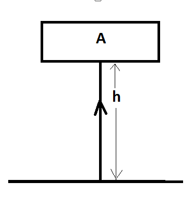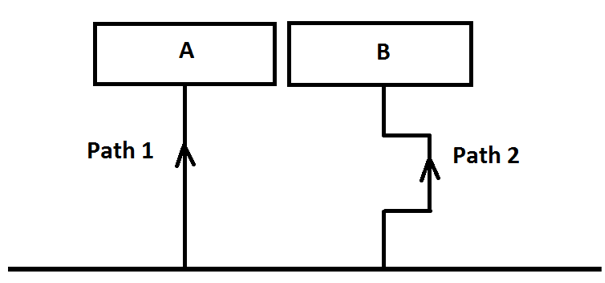The term potential energy was introduced by the 19th-century Scottish engineer and physicist William Rankine. There are several types of potential energy, each associated with a distinct type of force. It is the energy by virtue of an object’s position relative to other objects. In this article, let us learn what is potential energy, potential energy definition along with various examples and types.
| Table of Contents: |
What is Potential Energy?
As we know, an object can store energy as a result of its position. In the case of a bow and an arrow, when the bow is drawn, it stores some amount of energy, which is responsible for the kinetic energy it gains, when released.
Similarly, in the case of a spring, when it is displaced from its equilibrium position, it gains some amount of energy which we observe in the form of stress we feel in our hand upon stretching it. We can define potential energy as a form of energy that results from the alteration of its position or state.
After understanding what is potential energy and potential energy definition, let us learn the formula, unit, and examples of potential energy.
In this article, let us learn potential energy examples in detail.
Potential Energy Formula
The formula for potential energy depends on the force acting on the two objects. For the gravitational force the formula is:
| W = m×g×h = mgh |
Where,
- m is the mass in kilograms
- g is the acceleration due to gravity
- h is the height in meters
Potential Energy Unit
Gravitational potential energy has the same units as kinetic energy: kg m2 / s2
Note: All energy has the same units – kg m2 / s2, and is measured using the unit Joule (J).
-
For more information on potential and kinetic energy, watch the below videos:


You may want to check out the following related links
Types of Potential Energy
Potential energy is one of the two main forms of energy, along with kinetic energy. There are two main types of potential energy and they are:
- Gravitational Potential Energy
- Elastic Potential Energy
Gravitational Potential Energy
The gravitational potential energy of an object is defined as the energy possessed by an object rose to a certain height against gravity. We shall formulate gravitational energy with the following example.
- Consider an object of mass = m.
- Placed at a height h from the ground, as shown in the figure.
Now, as we know, the force required to raise the object is equal to m×g of the object.

As the object is raised against the force of gravity, some amount of work (W) is done on it.
Work done on the object = force × displacement.
So,
| W = m×g×h = mgh |
Above is the potential energy formula.
As per the law of conservation of energy, since the work done on the object is equal to m×g×h, the energy gained by the object = m×g×h, which in this case is the potential energy E.
E of an object raised to a height h above the ground = m×g×h

It is important to note that, the gravitational energy does not depend upon the distance travelled by the object, but the displacement i.e., the difference between the initial and the final height of the object. Hence, the path along which the object has reached the height is not taken into consideration. In the example shown above, the gravitational potential energy for both the blocks A and B will be the same.
Elastic Potential Energy
Elastic potential energy is the energy stored in objects that can be compressed or stretched such as rubber bands, trampoline and bungee cords. The more an object can stretch, the more elastic potential energy it has. Many objects are specifically designed to store elastic potential energy such as the following:
- A twisted rubber band that powers a toy plane
- An archer’s stretched bow
- A bent diver’s board just before a diver dives in
- Coil spring of a wind-up clock
An object that stores elastic potential energy will typically have a high elastic limit, however, all elastic objects have a threshold to the load they can sustain. When deformed beyond the elastic limit, the object will no longer return to its original shape.
Elastic potential energy can be calculated using the following formula:
Where,
- U is the elastic potential energy
- k is the spring force constant
- x is the string stretch length in m
Potential Energy Examples

Stones sitting on an edge of a cliff possess potential energy. If the stones fall the potential energy will be converted to kinetic energy.

Tree branches high up the tree have potential energy because they can fall to the ground.

The food that we eat has chemical potential energy. Our body digests this potential energy and provides the necessary energy for bodily functions.

The chemical potential energy of a firecracker is released when the fuse of the firecracker is lit.
Potential Energy Practice Question:
Q1: What will be the gravitational potential energy possessed by a ball of mass 1 kg when it is raised to a height of 6 m above the ground. (g = 9.8 m s–2)
Solution:
Here, the mass of the object (m) = 1 kg,
Displacement (height) (h) = 10 m,
Acceleration due to gravity (g) = 9.8 m s–2.
Hence, Potential energy (p) = m×g×h = 1 kg × 9.8 m s–2 × 10 m = 98 J.
Hope you understood in detail what is potential energy, potential energy definition, examples, and types. Stay tuned with BYJU’S – The Learning App to know more about various science and maths concepts.
Frequently Asked Questions – FAQs
Who coined the term potential energy?
Name some objects that possess elastic potential energy.
What are the factors that gravitational potential energy an object depends on?
What are the different types of potential energy?
The different types of potential energy are
What is the relationship between potential and kinetic energy?
The relationship between potential and kinetic energy is that they both can be transformed into each other. This can be explained by considering the water that is stored in a tank. When the tap of the tank is closed, water in the tank possess potential energy. If the tap of the tank is opened, then water will possess kinetic energy.


satisfying description of each topic.